>> This entire issue is available as a 15MB PDF download
Table of Contents
Publisher’s Message: Welcome to Powell River
A tale of two immigrants
Family Matters: A life lesson from the rocky beach
Listening to wood
Living Green: Alternative Transportation
2008 Texada Annual Fly-In
A Tale of Two Cities:
The rise and fall of Texada City
The changing face of a heritage hotel
Investing in staff
Eight-legged friends and tentacle-eating slugs
New wilderness program for struggling teens
Community Calendar
Explore Powell River

Welcome to Powell River
By Isabelle Southcott
My first trip to Texada Island was a camping trip just months after I moved here to work for The Powell River News in 1993. There was and still is something about that special island that calls to me. It is one of my favourite local get aways.
This issue focuses heavily on Texada Island, specifically, Van Anda, a community that was born long before Powell River. The area is steeped in history and its colourful past drew attention to it more than once.
Texada writer Gary Grieco initiated the Texada project in this issue of Powell River Living and we’re glad he did because it takes an islander to write stories about the island he calls home.
There’s a lot happening on Texada this month. Van Anda Days on July 12, the Fly–In on July 13, Sandcastle Days in August. Grieco has written passionately about Van Anda’s history and has produced a wonderful profile on one of the island’s many characters, canoeist/kayaker Diana Vaughn. Besides being an intrepid outdoors woman, Vaughn also happens to be the mother of Kim Miller, manager of the Powell River Chamber of Commerce!
Dawn McLean’s heartwarming conversation with two English as a Second Language students provides insight into their views on Powell River, while Roger Whittaker examines the heart of Dan Minard’s guitar-making workshop. Associate publisher Sean Percy takes readers along on a dive to Octopus City. These are the kinds of things that make Powell River such an interesting place.
If you are a visitor to Powell River, welcome! We hope you enjoy your stay and have a chance to sample some of our fabulous cuisine at the area’s many restaurants and cafes. If you happen to fall in love with Powell River, don’t fight it, just let it happen. I’ll tell you a little secret, many of our residents came here as visitors and ended up falling in love with this glorious community!
Powell Riverites are known for being friendly welcoming folks and we love nothing better than to share our beautiful community with others. There is so much we are proud of that it is difficult to know where to begin. The scenery, the amenities and of course the people. I hope you enjoy your visit and if you are looking for a new community to call home, please consider Powell River. We are the best community in BC; stay a while and you’ll see why!
A tale of two immigrants
Welcome to Canada
By Wendy Thomas
Powell River welcomes Alice Huang and Monika Spak, two immigrants who have fallen in love with the area and now call it home. They have been taking English as a Second Language at Vancouver Island University (formerly Malaspina University-College). Recently they sat down to answer questions from their instructor, Wendy Thomas, about their past, present and future.
Wendy: What is your background?
Alice: I lived in Tai Shan City in the province of Guang Dong in China. Tai Shan is a city bigger than Vancouver and is made up of ten suburbs, like ten mini cities. I worked for six years as an accountant at an electrical company.
Monika: I am from Miskolc, which is the second biggest city in Hungary. I worked as a nurse there for 20 years, the last ten were as a respiratory nurse.
Wendy: Why did you come to Canada?
Alice: My husband’s brother and daughter had just moved to BC, and my husband’s sister lives in Vancouver. We moved to Red Deer, Alberta, when we first arrived in Canada. My husband had a job there as a cook and I went to school learning English.
Monika: My story is very interesting. I had been corresponding with a Hungarian man named Tim who lived in New Westminster. Through the computer we learned a lot about each other. We wrote for a half a year and then Tim came to Hungary to meet me. He invited me back to Canada for a visit and I ended up staying.
Wendy: How did you decide on Powell River?
Alice: A friend in Red Deer, Dan-ni Tseng, had just bought the Sky Dragon Restaurant at the Crossroads Plaza. She encouraged my husband Heping and me to join her and work there.
Monika: Tim had seen Powell River photos on the computer. He was looking for a place to retire and suggested that we live in Powell River. We came, we saw and we moved into an apartment within two weeks!
Wendy: What were your first impressions of Powell River?
Alice: I liked the ocean and the feel of the air. It is fresh and not too dry. I also loved the mountains. Right away I found the people so friendly.
Monika: It is a small town, but it is very big. The many lakes and little mountains add so much. Tim and I love to explore and have discovered many natural spots in the area.
Wendy: What do you like the most about being here?
Alice: I like the fact that you can pick up oysters so easily here. In China, oysters are so expensive. I could eat oysters every day here! As well, I love that Powell River is so relaxing. It is easy to get things done.
Monika: I like everything! My city was busy and crowded with buildings and houses. Powell River is very nice.
Wendy: What is the most difficult part of moving here?
Alice: My Powell River allergies! I sneeze for most of the year. But that is nothing compared to missing my family in China. I talk to my mother, Mei Dan Ma, every night.
Monika: It’s the same for me. I miss my mother Margit and daughter Timea terribly. And sometimes the rain is depressing. But, when the sun is out, I cannot be sad.
Wendy: Since you are both still learning English, you must have had some funny or embarrassing moments in Canada. Can you think of one?
Alice: When I first arrived in Canada, my friend took me to a casino. They are very different in China, and I was amazed. I needed to find the restrooms and I asked one of the casino employees, “Where is the wass oom?” Of course he didn’t understand me. I repeated my question to many people, “Where is the wass oom?” I had to search everywhere to find it myself!
Monika: Because Tim is with me around town, I have my own personal translator. But in English class, I have to answer questions. I will feel under a time pressure and answer the questions quickly. Then late at night when I am thinking about my day, I will remember my answers from class. I will think about any mistakes I have made. I am so embarrassed then.
Wendy: And now, when you two think of the future, what do you see?
Alice: I would love to live in Powell River forever. I think it is a great place for seniors. It’s senior city! Right now I work really hard at the Sky Dragon Restaurant, starting at 11 a.m. and finishing at 9 p.m. But even though I am tired, I know my future is brighter here. It seems as people get older in Canada, life gets better.
Monika: Right now we are enjoying Tim’s retirement. But I am ready to get back to work. I miss working as a nurse. I would like to continue studying English and get back to my career. That would make life in Powell River perfect.

A life lesson from
the rocky beach
By Isabelle Southcott
I was lying on the rocks on the beach just below the Seawalk one warm Sunday afternoon not long ago and this peaceful feeling that all was well with the world washed over me. My eyes were closed, my ears were open; I could hear my children and their friends laughing as they built a fort in the tall grass above me. A gentle ocean breeze blew over me; the sound of the waves as they lapped up against the shore was music to my ears. I could hear the faint trickle of a stream from somewhere not far away as I dozed off.
Minutes, maybe even seconds later, I awoke with a start. My overactive brain was making a list of all the things I should be doing. It took a bit of willpower as I fought the temptation to jump up and start doing something rather than nothing and just being. What was I doing wasting time, a little voice inside my head my chastised me. Wasting time? I replied. What could be more important in life than being with my children and enjoying this paradise I call home. This paradise we call Powell River.
A snatch of conversation between the boys, a gull squawking overhead, and my son’s Nova Scotia Duck Toller asking that his stick be thrown for the umpteenth time are important moments in life. They are every bit as, no, more important as the “to do” list at home.
I pulled myself back to the moment so I could enjoy life as it was, as it is, and not how it will or might be. The only constant we have in life is change and all we can be sure of is now, so today is a gift to celebrate.
When children are creating and inventing something, such as a fort, they can be remarkably focused. Without adult supervision or interference, my two boys and a friend were having a great time. It was unstructured play at its finest. They were working together, solving problems, coming up with new ideas. They were a team.
Times like this are good lessons for the future. There is no “I” in team. We work together. In many ways children working on a project or adults working on project for leisure or work are similar. Lessons we learn as children about teamwork will carry us through life and we will use them time and time again. In order for one member of the team to succeed, we all have to succeed. It takes a group effort to build a great fort. It takes a group effort to raise children. It takes a group effort to do many of the most important things in life.
The sooner we learn the value of working together, the better off we are. When we work together the most amazing things can happen. Be it families, organizations, businesses or communities, groups that work together are stronger than those who don’t.
Anyhow, that’s how I see it from the rocks on the beach!
Listening to wood
By Roger Whittaker
Now I have heard there is a secret chord that David played, and it pleased the Lord.
Hallelujah, by Leonard Cohen
Dan Minard holds a piece of Sitka Spruce between his thumb and forefinger, similar to the way one does when they are taking out a piece of foul smelling fish. He leans in with one ear and, using his free hand, taps the wood in several places. “Listen to that,” he says grinning. “The note lasts…” his voice drifts off as he taps it again and leans in closer to groove on the reverberation of resonance.
Beside him on the table in his heated shop are two stacks of Sitka Spruce and Red Cedar, re-sawn from rounds and bolts. The cupboards also boast shelves full of guitar fronts awaiting shipment to guitar factories around the planet. The secret to his business of supplying excellent BC wood products to the guitar factories of the world is not contained in the laser-guided table he created for slicing bolts and rounds with minimized waste and micrometer aligned precision accuracy. Nor is the secret hidden in the variable height table sander he designed and built. No, the elusive secret to this luthier’s success is his ability to look upon a bolt or round and discover the medullary rays hiding in the wood, then slicing each front or back set in such a way that, once polished and finished, these rays will dance upon the surface of the wood. To the casual layman who is not wood or music savvy, the display is almost akin to hearing, with your eyes, how the wood will sound.
Dan discovered he had this innate knowledge and spent some time increasing his understanding of wood for instruments, studying under Guitar Guru, Scott McKee, who now lives in Cumberland. The awakening of a lifetime desire to create fine musical instruments moved Dan to leave his career in aircraft mechanics, and commence a life devoted to the discovery of perfect medullary rays.
The wood that makes the best guitar backs or sides, according to Dan, is Brazilian Rose Wood, a wood so popular it has now become an endangered species. Dan relates, “At the recent Montreal Guitar Festival, many American luthiers were compelled to leave their very best products at home because Canada does not allow goods created from endangered species across the border.”
Dan detailed the luthier experience further, “Exotic woods grown in equatorial countries experience a climate that has ‘two summers’ one at each end of the equinoxes. However, local Broad Leaf Maple makes beautiful looking and sounding guitars. Building instruments from oily exotic woods presents a myriad of challenges when it comes time to fasten the bits together. Modern chemical glues are the least effective and the tried-and-true hide and hoof glues created by the ancients provide the quality bond required to keep the pieces together for the life of the instrument.”
Raincoast Tonewoods, Dan Minard’s company, exports guitar soundboards and backs from the forest floor of British Columbia to be fashioned into guitar players’ dreams the world over. Each piece is selected, sawn and dried to enhance the natural ability of the wood to sing in the notes naturally emanating from the life of the tree. In his private luthier moments, Dan selects quality wood and, from the signature mother-of-pearl inlay on the headstock to the strap peg on the body, he infuses workmanship that will sustain notes of his being long after the frets of this world have passed.

Alternative Transportation
By Emma Levez Larocque
How do you get to work? If you’re like most of us, you jump in your car and drive there. But as fuel prices soar and the state of the environment becomes increasingly pressing, a growing number of people are considering whether that’s the best idea.
Cars are expensive, in more ways than one. The gasoline we need to fuel them will empty wallets quickly, and when we look at the damage their emissions are doing to the earth, it’s impossible not to see the havoc they are wreaking.
But we all drive. How can we NOT use our cars? We need them every day—to get to work and back, to visit our friends, to take our kids to school, to do groceries.
Think about this scenario. If you woke up tomorrow and there was no more gasoline—none, not a drop left to buy for any price, how would your life change? How would you survive? Would you lose your job? Would you stop going to school? Would you have to move? Would you have to give up events and hobbies that you love? How would you cope? How would you manage?
There are, of course, other—non-motorized—ways for us to get around, biking and walking being the two most prevalent. We have become entrenched in the age of the car. Our lifestyles are fast-paced and busy. We have jobs, school, activities, lunch dates—and we can’t do it all without the use of a car. You may not be able to stop using your car completely, but you can almost certainly cut down on how much you use it. By planning your week and practicing “trip chaining,” you may be able to do without your car one or two days a week.
As far as cities go, Powell River is small, but it’s relatively spread out, which can make it difficult for people who live some distance from their place of work. Still, it’s not impossible—it just takes a shift in the way you think about things. Instead of saying, “I can’t do that—it’s too inconvenient,” think about what you can do.
Jonathan Lyster lives about five kilometres away from his place of work. A couple of years ago he decided to get out of his car and onto his feet or bike a few days a week. He planned his week out so he could do errands on set days, and on days when he didn’t need his car, he ran or biked to and from work. Two years later, he’s still committed.
“It was a way for me to get into—and stay in shape,” Jonathan says. “I became healthier for it, and it is a great way to wind up before the day starts, and wind down again after the workday is over. It’s a great stress management tool, and I feel good about using my car less.”
There are definite advantages to using non-motorized transportation, but in today’s world, that’s not practical for a lot of people all the time. But even in small towns like ours, public transit systems are improving and increasing in flexibility, car share programs are forming and rising in popularity, and alternative, efficient vehicles are becoming more prevalent. There are several hybrids already on the market—and completely electric cars are also becoming available. Go to www.businessweek.com and search “electric car” for a story about the THINK Ox, an affordable electric car soon to be on the US market.
Some ideas for using your car less:
- Make a commitment to use an alternate mode of transportation to do something you regularly do at least once a week. Make your goals realistic so you can stick to them, and be sure you leave yourself enough time so this commitment does not become stressful.
- Instead of driving to the place you exercise, exercise right from home—get on your bike and go for a bike ride, or go for a walk or run from your doorstep.
- Combine your errands. If you plan and organize your week, you can reduce the amount you need to drive to get things done.
- Walk or bike to school with your kids instead of driving them. The fresh air will start their day, and yours, off on the right foot.
- When you go to town and have several stops to make, park somewhere central and walk to all the places you need to go, instead of driving from place to place.
- Carpool to work or events when there is more than one person going the same way. Share the price of gas so everyone benefits.
- Take the bus.
- Make it fun! See how many days in a month you can go car-free and reward yourself and your family for record months.
2008 Texada Annual Fly-In
By Gary Grieco
Texada’s Second Annual Fly-In is fast becoming an annual pilgrimage for private pilots who “fly in” from all parts of BC to swap stories with their Texada counterparts. Information travels freely and quickly wherever there are clubs and small airports.
This year’s fly-in is Sunday, July 13.
“The flying community has its own kind of communication system, and the lure of a flight to meet with other fliers and aviation buffs is always a welcome occasion,” according to Doby Dobrostanski, a key organizer, and one of Texada’s noted artists who has immortalized many of Canada’s famous military aircraft on canvas.
What started almost as a spontaneous event in 2007 has now developed into a well organized machine. Bob Timms, President, of T.A.C.T.—Texada’s Arts, Culture and Tourism, the community organization sponsoring the Fly-In—is looking forward to as many as fifty private and Government aircraft arriving for the week-end get-together at Texada Island’s airport in Gillies Bay.
Aviation enthusiasts and the public are invited to the Fly-In, which kicks off at 9 am Sunday with a pancake breakfast inside one of the hangars - come rain or shine. The day will be jam-packed with eye grabbing, aviation oriented displays and aircraft, games for the kids, live entertainment and an afternoon BBQ luncheon at one pm.
RCMP aircraft will be on display, along with their pilots who will answer your questions about the force and their aviation duties. Well known west coast author and pilot, Wayne Lutz will be on hand with a power point presentation of flying in BC. The Texada Heritage Society’s visual display about airport history will run continuously throughout the day for the history buffs. KD Air, a commercial carrier and integral part of the airport’s operation with their daily flights between Texada and Vancouver’s International South Airport, will be on hand with an aviation exhibit. The Canadian Armed Forces Search and Rescue may even make an appearance with their Canadair Buffalo and new Cormorant helicopter.
The Fraser Blues, a crowd pleasing, precision formation flying demonstration team will wind up the day with a demonstration of some of the best aviation formations manoeuvres that civilian pilots have to offer over the “biggest little airport” in the world at approximately 2:30 pm. Officially formed in 2001, this group of five pilots and four ground crew perform more than 35 shows per season. The pilots have a variety of backgrounds from ex-military to airline captains and, like the team, the aircraft they use are unique as well. Flying classic Navions, built by North American Aviation after WWII for the civilian market, the Navion first found favour with the US military and eventually saw combat during the Korean war. The Navion was actually on the North American wartime drawing tables in 1945 to become a four-seat forward-area liaison aircraft which would replace the “Piper Cub” types that were currently doing the job during the conflicts. With the end of the war in sight, the plans to produce the aircraft were shelved, and when peacetime finally happened this very civilian-friendly design was ready for production. The Fraser Blues team makes formation flying look easy in these beautifully reconditioned 50-year-old-planes.
“Good flying weather, please ‘Sir’ for the entire July 12-13 weekend.”
For more information and a downloadable map of Texada Island go to Texada.org.
A TALE OF TWO CITIES
The rise and fall of Texada City
by Gary Grieco
Texada Island, known as “Canada’s most precious rock” in the late 1890’s, was declared the richest 25 square miles in British Columbia with its twin side-by-side cities, named Van Anda and Texada City. These were illustrious titles for real estate that only few years before had been reported in the Courtenay Comox ‘Weekly News’ to be a “mountain of rocks, having no flat or arable land except a few small swamps.”
The excitement started with a fisherman named Harry Trim who sailed into Welcome Bay in 1871 and recognized iron ore staining on a hillside that today is the site of La Farge’s giant TQL Quarry. The discovery of iron ore, tinged with greed, created a scandal that brought down Premier Amor de Cosmos’ fledgling Provincial Government.
The discovery of precious metals excites a fever and optimism in all men. The 1880’s in Van Anda ushered in an unparalleled era of prosperity with gold and copper being discovered in the Little Billie, Copper Queen, Cornell, and Marble Bay mines. Prospectors swarmed all over the island locating new claims daily. Some had formal titles like The Charles Dickens or Commodore, while others were tagged with more colourful names: The Loyal, Volunteer, Black Prince, and Red Cloud.
By 1898 mining was king. Van Anda was now a city and quickly turning into a full-fledged mining camp with the Copper Queen as her pulsing heart, while the newly discovered Cornell and Marble Bay mines promised fabulous riches. Van Anda began to take on a metropolitan appearance, with its two-story boarding house, store, mine houses and residences; but now she had a rival—Texada City.
Texada City came to life with the development of the Marble Bay Mine. Attention shifted to Sturt Bay, the largest bay on the eastern coast of Texada, and now the home of the Texada Boating Club. Enthusiastic plans included the offering of lots in the Texada City townsite at $150 for corner lots, and $100 for inside lots. A $5,000 hotel was to be given away in a draw from among the 300 paid up purchasers, but no more than 10 or 12 lots were ever sold, and the raffle was never held. However, the 28-room Marble Bay Hotel did get built and this is where most of the single miners lived.
At the outbreak of the First World War in 1914, the unbelievable word flew around the town—the mines were through; they were shutting down. It was true, and soon Van Anda took on the aspects of a ghost town as the miners and their families moved on to new opportunities. The twin cities of Van Anda and Texada City as gold and copper mining centers sank back into comparative obscurity.
Texada City is now but a faded memory, and the once rich mines of Van Anda are covered and hidden. Take a stroll in the early morning mist, and if you concentrate, sights of yester-year may appear from the corner of your mind’s eye. Hazy visions just might materialize of the old Opera House, the pretty white Church, or, husky bearded miners standing around at the old store. A horse-drawn wagon loaded down with equipment creaks down the dusty main street in ghostly fashion, while a lone policeman pauses to chat with one of the boys. Lurid posters on the side of a building announce the coming of a new dancer to Vancouver, along with a special boat sailing for the event. The images grow dim, and then fade from sight, like the boom days of Texada City and Van Anda when they were home to over 5,000 people.
Texada Island today remains one of the few Gulf Islands with an industry-based economy and a growing retirement population.
Its natural beauty, three working limestone quarries, a handful of forestry companies, agricultural and small businesses ranging from artists to building contractors, and telecommuting corporate workers and landscapers all contribute to a healthy community of approximately 1,100-plus residents.
The changing face of a heritage hotel
Townsite’s Rodmay Heritage Hotel home to small businesses
By Isabelle Southcott
When people work together amazing things can happen. The Rodmay Heritage Hotel in the Townsite is an example of a building and an environment that has been changed by the coming together of a group of people to create an effect greater than that predicted by a single person.
Three years ago a group of investors purchased the almost-100-year-old hotel. It had been badly neglected and a ton of work needed to be done to bring it up to snuff.
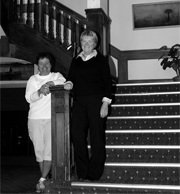 Joan Campbell, financial officer and spokesman for The Rodmay, says a lot has happened in the last three years. Today there are 20 rooms and two suites open, a pub, a beer and wine store, a book keeping business, a consulting firm and a second hand shop. “We’ve redone the coffee shops, now we’re just waiting for the right operator,” said Campbell.
Joan Campbell, financial officer and spokesman for The Rodmay, says a lot has happened in the last three years. Today there are 20 rooms and two suites open, a pub, a beer and wine store, a book keeping business, a consulting firm and a second hand shop. “We’ve redone the coffee shops, now we’re just waiting for the right operator,” said Campbell.
Besides offering rooms for rent, the hotel also rents out its facilities for events.
Changes at the Rodmay are evident from the moment you walk through the door. The energy of having several small businesses located on the premises adds to the vibrancy.
History of the Rodmay
Built in 1911 by Andrew McKinney, the Rodmay (then Powell River Hotel) was the Townsite’s first hotel. The original hotel consisted of 31 rooms. The hotel was purchased by Rod and May MacIntyre in 1917 and renamed The Rodmay. It was taken over by their son Batt in 1928, a year before Rod’s death. Batt managed and expanded the hotel business until he sold it to Al Mantoani and a group of investors in 1957. The hotel continued to operate but during the last several years it remained vacant until Campbell and investors took it over in 2005.
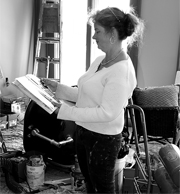 When Campbell’s group took over the hotel it was a mess. “When we first walked in we had to use flashlights. There were three people living here but the business had not been operating. Some people thought it should be torn down,” said Campbell. The third floor was filled with rubble and debris. There was no heat, windows were broken, the front was overgrown with blackberries, the basement was flooded and it looked like a haunted hotel. “For the first few months all we did was clean.”
When Campbell’s group took over the hotel it was a mess. “When we first walked in we had to use flashlights. There were three people living here but the business had not been operating. Some people thought it should be torn down,” said Campbell. The third floor was filled with rubble and debris. There was no heat, windows were broken, the front was overgrown with blackberries, the basement was flooded and it looked like a haunted hotel. “For the first few months all we did was clean.”
Alea and Henry Newport, owners of McKinney’s Pub, and Linda and Bill Fonseca, owner of The Heritage Liquor Store and Centsibles-Too, are also shareholders in the hotel. “This is a joint enterprise,” said Campbell. It’s too big for one person to manage. We have a corporation of shareholders.”
They’ve held art shows, poetry readings, social functions, workshops and dancing lessons at the hotel. Renovations are ongoing.
Alof!i Consultancy
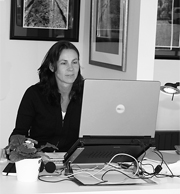 Christien Kaaij of Alof!i Consultancy is an experienced workshop facilitator and has worked for over a decade as a project and program manager in community building and planning projects. She describes her firm as a socially engaged consultancy firm that focuses on the non-profit market.
Christien Kaaij of Alof!i Consultancy is an experienced workshop facilitator and has worked for over a decade as a project and program manager in community building and planning projects. She describes her firm as a socially engaged consultancy firm that focuses on the non-profit market.
The Heritage Liquor Store
Located in the Rodmay Hotel, The Heritage Liquor Store is owned and operated by Linda and Bill Fonseca. It carries a wide selection of wine, beer and spirits and cell phone cards.
Industry Council for Aboriginal Business
Katrin Harry is the executive director of the Industry Council for Aboriginal Business. She runs her business out of the Alof!i office at the Rodmay Hotel. ICAB’s vision is to realize a vibrant business economy where Aboriginal and non-Aboriginal people prosper together.
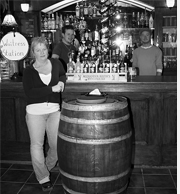 McKinney’s Pub
McKinney’s Pub
Owned by Henry and Alea Newport and Shawn Bateham, McKinney’s Pub opened in October of 2007 after extensive renovations. “I wanted to give it a heritage feel, to make it an old English style pub,” said Alea. There’s an old world feel to McKinney’s with its wine barrels, dark stained wood and brass railings. “We provide reggae, blues, gypsy jazz and have comedians.” Free Salsa and Merengue dance lessons are provided on Tuesday evenings.
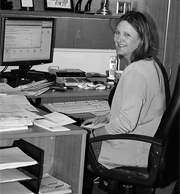 Lisa’s Bookkeeping
Lisa’s Bookkeeping
Lisa Beeching recently moved her successful home based bookkeeping business to the Rodmay Hotel. Beeching has been helping her Powell River clients with all their payroll and bookkeeping needs for several years. She outgrew her previous location and finds the Rodmay location welcoming and convenient.
Centsible-Too
This is where you can find great deals on second clothes and furniture and a whole lot of other goodies in the Townsite. Centsible-Too has a sister store located on Marine Avenue in Westview.
Investing in staff
Professional exchange offers benefits
Exchange programs are exciting for both students and adults for many reasons. Not only are you exposed to different cultures and ways of doing things but also the opportunity to see how others work and learn is fascinating.The City of Powell River’s chief administrative officer Stan Westby is participating in an exchange with Susan Jones, human resources and administration manager for the District of Gore, New Zealand. The Local Government Managers’ Association sponsors Westby’s program.
Jones was in Powell River last month on her part of the two-week exchange. “I am going to pick Susan’s brains and vice versa,” said Westby.
Jones said the exchange is like an exploratory and not a job exchange. “There are a lot of similarities between Canada and New Zealand for local government.”
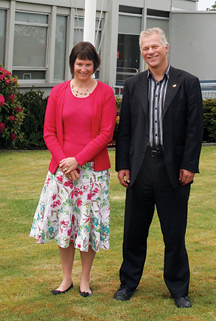 The two attended the Local Government Managers’ Association Conference together. Westby will travel to New Zealand in September for his part of the exchange. He too will attend a local government managers’ conference and network with others in his field. “I will participate in every way I can. I will spend a week in Gore and immerse myself in their municipal culture, learn and share municipal information.”
The two attended the Local Government Managers’ Association Conference together. Westby will travel to New Zealand in September for his part of the exchange. He too will attend a local government managers’ conference and network with others in his field. “I will participate in every way I can. I will spend a week in Gore and immerse myself in their municipal culture, learn and share municipal information.”
Gore has a population of 12,500. It is primarily a rural servicing town for the agricultural sector. The median age is just over 40 with nearly 17% of the population aged 65 years of age and over.
Westby is particularly interested in how New Zealand is making significant advancements with regards to reporting infrastructure. “I have a huge interest in that from being chairman of the National Round Table on Sustainable (non-technical) Infrastructure,” he said. “I want to meet with a number of people who have put that process together.”
As well, New Zealand has made significant inroads into its asset management and reporting scheme and as a result local government has to account for depreciation of everything such as roads, water pipes and sewer.
“We are still based on historical costs. In this country we have never focused our energy on that area. What can we learn from those who are ahead of us in that regard?”
Jones commented on how much she liked the announcement portion of council meetings and noted that there is obvious pride in the community.
The only complaint she had about the exchange was that it was too short!
Eight-legged friends and tentacle-eating slugs
It’s a different world under the waves
By Sean Percy
With our house in disarray and still sans kitchen following our recent attempts at home makeover, I figured taking a day to go scuba diving was out of the question for the sake of marital peace.
But then my boss suggested that an article on scuba diving would be a good fit for our July issue so I had to go. Sometimes bosses aren’t so bad.
The folks at Alpha Dive and Kayak had arranged a fun dive excursion on a Friday evening at the Saltery Bay picnic site, and that event fit the bill perfectly. However, I hadn’t been diving in the ocean in almost a year, and my dive buddy, my father, was testing out a new buoyancy compensator. So, rather than holding back the 12 divers heading out to the anemone field off Kent’s Beach, we set off on our own towards Octopus City in the hopes of rousting out some of its eight-legged denizens.
We suited up and walked into the water at the boat launch. After double checking all our connections, valves and seals, we descended and began the swim west across the sandy bottom.
In just nine feet (3m) of water, we ran into a small copper rockfish (Sebastes caurinus), lurking in the waving fronds of eelgrass. A moment later it was apparent why he had been attracted to the shallow water, as we swam through a shoal of sand lance, commonly called needlefish (Ammodytes hexapterus). Then a school composed of a variety of species of perch flashed by.
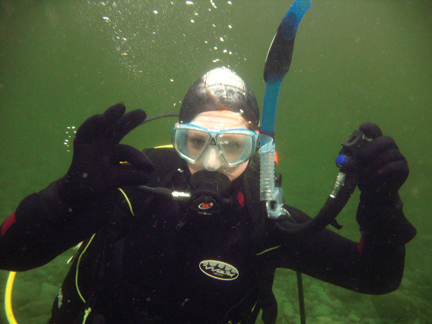
As we got into deeper water, the nutrient-rich water became a soup of living things, many so small as to be almost invisible. But one, about a centimetre across and two centimetres long, caught my eye. The little jellyfish was transparent, save an orange band above a fringe of tentacles only a millimetre or so long. I hadn’t seen this species before, and was mesmerized by the intricate details of the little creature, but was brought back to reality by the realization my father’s fins were disappearing into the distant green. I sprinted to catch up, then we swam together a few feet over the sandy bottom, watching as Pacific sand dabs (Citharichthys sordidus), C-O sole (Pleuronichthys coenosus), and a variety of other flatfish darted away at our approach.
We soon came on the submerged cable that runs from the shore out to the massive boulders that form Octopus City. Crab shells littered the entrance to a cave dug under a boulder the size of a compact car. My breathing quickened. This was why we had come to this spot. Would the Giant Pacific Octopi (Enteroctopus dofleini) be home? My flashlight probed into the darkness, and by standing on my head to get a good view, I was able to make out white suckers on the octopus tentacles. The suckers were larger than a toonie, making it a good-sized octopus. She refused to come out and play, but as I rose above the bottom four copper rockfish and a male kelp greenling (Hexagrammos decagrammus) greeted me as they hovered between a stand of plumose anemones growing on top of the rock. At first, I counted three white and three orange anemones, but on closer inspection, there was another orange one that had withdrawn into itself. Instead of resembling a cauliflower with a long stem like his neighbours, this example of Metridium farcimen looked like a sloppy cow patty.
We moved over to a second large boulder in slightly deeper water at 65 feet. Another octopus was home here, but also dug deep into his burrow far beneath the rock, and not interested in company. He was slightly smaller, with his largest suckers only about the size of a loonie.
We were soon distracted by a giant nudibranch (Dendronotus iris) dancing in the water column about 10 feet off the bottom. A close relative of the slug, the nudibranchs got all the looks in this family. About 10 inches long, it is partially transparent, with frosting at the tips of the dozens of soft, delicate spines along its back and a white edging along the bottom foot. But the soft and delicate appearance belies the predatory nature of this creature. They crawl around the bottom in search of their favourite snack – tentacles of the burrowing anemone (Pachycerianthus fimbriatus). When they find one, they rear up and pounce. The anemone withdraws into its burrow in a flash, but the nudibranch usually gets a mouthful of tasty tentacles in the process.
Usually, nudibranchs of all sorts crawl around the bottom grazing, but on this day we spotted three giants “dancing” a few feet off the bottom. I’ve seen Dendronotus iris swim to escape predators, but none are in sight. I wonder if perhaps they’re planning to attack their hapless anemone prey from above.
Later, we see a cluster of nudibranch eggs. Feather dusters or crinoids (Florometra Serratissima), relatives of the starfish and sea urchins, festoon the rocks, waving their arms to filter small particles of food from the seawater. The greenling from the octopus rock escorts us as we head into shallower water. At 47 feet, we find a crab trap, perhaps lost in a storm. I wonder briefly how many crabs it killed before it rotted, and I hope the user had used the regulation rot cord designed to keep such traps from becoming continuous killers. But this trap’s capturing days are long over. It is partially collapsed and now covered in sponges, bryozoans, anemones and feather stars. A sand dab darts away as we swim over, and crashes into a sculpin, who seems annoyed at the intrusion, but only moves a couple of inches. A hooded nudibranch, Melibe leonina, drifts in the current, its bulbous hood waving in the current to catch tiny crustaceans.
A sea star (Evasterias troschelii) catches my eye because of its unusual shape. We’ve seen dozens on this dive, but this one, instead of the normal five arms, has three normal-size arms, one that has been chopped half off, and the fifth is just a tiny stub beginning to re-grow, probably after it broke it off like a lizard’s tail to escape some predator. Life has been difficult for this starfish. But it seems to be doing well now, feeding on a small clam.
Life is everywhere on the ocean floor, but our time here is too short. Nearly an hour has passed, and our air supply is running low, but it seems as if we have been down only a few minutes.
After peeling off our dry suits and stowing our equipment in the car, I visit with the other divers over a piece of Helen Whitaker’s key lime pie. Whitaker had found a bottle to add to her collection.
“I find something neat on every dive,” she said.
The highlight for Jason Dunkley was spotting a two-foot halibut, which, he said, wasn’t even scared of him.
Eilish Murphy said she enjoyed the variety of life, particularly a two-foot wide sun star (Pycnopodia helianthoides).
“It was funny when (dive master) Scott (Friesen) wore that as a hat,” said Murphy.
Erwin DeBruin, visiting from Leiden, Netherlands, called the dive “a great experience.” He wouldn’t single out a highlight. “Saying the highlight was one big sea star and a big fish just doesn’t do the dive justice,” said DeBruin.
Event organizer Kathy Friesen said the Friday evening dive and kayak session proved more popular than the usual weekend fun dives. In all, 25 people were involved in the dive, kayak and picnic.
“Having the kayaks here for the non-divers was fun,” she said. “It was a really great evening.”

New wilderness program for struggling teens
School District 47 and Terracentric Coastal Adventures Ltd will launch a joint-venture pilot program in April 2008 that will help struggling teens rediscover their strengths and experience success.
Terracentric’s Hugh Prichard is the Jade Coast Rediscovery Program coordinator and founder. He’s excited about the program, which will help fill a gap for 13-to-18 year olds who are struggling to find a therapeutic program that will focus on results.
“The board of education identified the need for this type of program many years ago and has a huge vested interest in the program because if we do not take care of our children’s physical, social and emotional needs first we will never get to the point where we can educate them,” said Jay Yule, School District 47’s Superintendent of Schools.
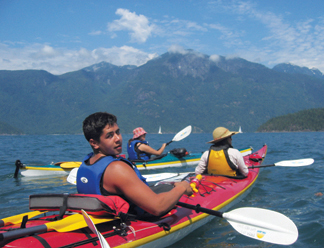
Terracentric has been working with School District 47 for ten years designing and delivering adventure based learning programs. Prichard and Cindy Smith, Terracentric’s Therapeutic Coordinator, say the idea is to create a program that will focus on young people providing them with the opportunity to challenge themselves and develop skills.
“The board of education made a conscious decision to get tough on drugs with severe consequences however we feel an obligation to help students who are out of school be able to return ready to learn,” said Yule.
The idea behind this rediscovery program is to connect with ancient wisdom. The Jade Coast Rediscovery Program is connected with “The Journey” as in the journey through the waters of Desolation Sound and the journey through life.
Participants will go on a 30-day supported wilderness based journey in the Desolation Sound area. They will be camping but will be in a safe environment and have regular opportunities to connect with support staff. They’ll be challenged to acquire new skills and use the skills they already have. They’ll learn about the power of self and how to build healthy relationships,” says Smith. There will also be a strong component of before and after care.
Before the journey begins youth will do individual work and learn “hard skills” necessary to spend time on the water and land. Once they return, they will be supported to transfer what they’ve learned back into their everyday life.
All the things participants need to be successful on the journey are the same skills and attributes that they need to go through life. There will a strong focus on individual success as well as success for the team. Metaphors, such as how paddling into the wind and facing an obstacle in the wild is similar to what happens when you come up against an obstacle in life, are used. “How do you cope?” asks Prichard. “Do you focus on small goals like that rock that is 20 metres away? Do you sing a song to distract yourself from the pain or the blister on your foot? What are your strategies for success?
The Jade Coast Rediscovery program is an opportunity for people to challenge themselves, develop new life skills and put together an action plan that will help them work through life’s challenges. It’s about setting goals, both long term and short term, and how to apply what was learned on the journey to everyday life, adds Smith. “It’s an individual process and each participant has an individual success plan they will work on. Although they will be challenged they will still be heard and make decisions for themselves and the group,” says Smith.
Communication skills are a huge part of the program. They will be able to use these skills today and use those skills in adulthood when they hit a brick wall.”
They will learn flexibility, empowerment and success. In fact, this program is set up for success. “They’ll come out saying ‘wow, I did that!,’” says Smith.
This program focuses on the four quadrants of health: spiritual, emotional, physical and mental. Prichard notes that generally young people no longer have the “coming of age” or “rite of passage” that they once did. This program will only work with the commitment of the community to supporting vulnerable youth, said Yule.
It also depends on a strong partnership between School District 47, Tla’Amin Community Health Services, Vancouver Coastal Health and Health Canada.
“It’s about focusing on core community issues that need to be addressed and meeting youth at their level instead of sticking them just in treatment beds, which research has shown has little success,” says Prichard.
Smith says it is all about providing an environment that encourages change. “They need to know how to change, they want to change but must be allowed to change and people have to allow that change to continue when they return.”
Students who participate will receive academic credit for this program and program designers are building a plan to make this program financially accessible for youth and their families. This will be only the fourth program of its kind in Canada.
Sunshine Speakers Toastmasters: Interested in communication, leadership and public speaking? Toastmasters next meeting is 6 pm July 28. “A Taste of Toastmasters,” is a potluck summer meeting that is sure to be fun. Please call Jim at 604 485-4355 or Kevin 604 483-9052.
Second Tuesdays: Living with Cancer Support Group, 1:30–3:30 pm at Breakwater Books, Alberni St. All cancer patients, survivors and loved ones welcome. For more information, 1-888-229-8288.
Third Tuesdays: Powell River Garden Club meets at 7 pm at Community Living Place.
July 1 – 5: Kathaumixw presents 18 spectacular concerts, 6 choral competitions and 3 vocal solo competitions. A complete list of choirs and artists can now be viewed at www.kathaumixw.org
July 9: A Life Before Plastic display sponsored by Pebble in a Pond at the Powell River Historical Museum. 9 am to 4:30 pm seven days a week, July and August. Grand opening Wednesday, July 9 at 7 pm.
July 12: Jazz Vespers at St. David and St. Paul Anglican Church. A service of music and meditation, 4:30 pm. Hannah Main-van der Kamp will read and Jim Dickson will provide the music. Everyone welcome. For more information call 604 483-4230 or 604 487-0750.
July 19: 7:30 pm, Italian Community Club hosts musicians from the Slavic northeast region of Italy who will perform traditional folk music. Everyone welcome. Admission by donation.
July 20: Savary Island Fun Triathlon. Bike, swim, run begins at Savary Island dock. Race Director: Paul Cummings 604 485-0855.
July 20: Open Air Market is hosting a celebration of BC farming from 12:30–3 pm at the Open Air Market on McLeod Road, Paradise Valley. Corky Evans will be the guest speaker.
July 21: Monthly support group meeting for families affected by mental illness. At the Source Club, 4476 Cumberland St, 7 pm. For more information or a ride, please contact Lin Johnson, BC Schizophrenia Society, 604 486-0114.
July 25-27: Seafair, Willingdon Beach. This festival offers a multitude of fun events for all ages. Starting with a treasure hunt, children’s coloring contest, and a business decorating contest. Food booths, crafts and information booths, outdoor entertainment, midway, bingo, parade, fireworks, kid’s day races, sandcastle contest and talent contest. For information call Donna Rekve at 604 483-4220. www.seafair-powell-river.com
August 1: Happy BC Day—provincial holiday.
August 7: Summer Curling Bonspiel, Powell River Curling Club. Fun for everyone. For more info call 604 483-9551.
August 16: Art in the Park Local artist works on display at the beach, children’s art, music.
August 16: Texada Sandcastle Weekend. Enjoy Island fun at the Texada Sandcastle Weekend. Various locations on Texada Island. For more info call Lee Thorp 604 486‑7675 or visit www.texada.org/eventscalendar
August 16 -22: Blackberry Festival is a week-long celebration of the delectable berries that grow in abundance in the Powell River area. There are different events each day winding up with everyone’s favourite, the Marine Avenue Street Party.
Community calendar provides free listings for non-profit organizations and our advertisers. To post your event email bonnie@prliving.ca.
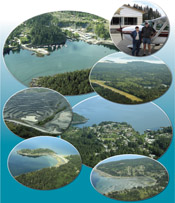
Texada from the Air
by Margy Lutz
with special thanks to pilot
Dale Wright & the Westview Flying Club


